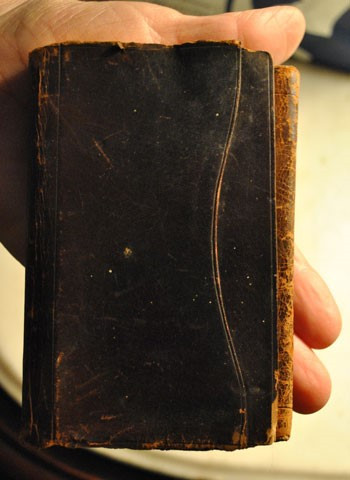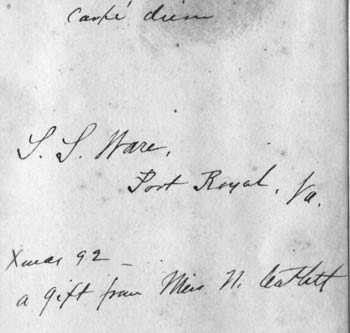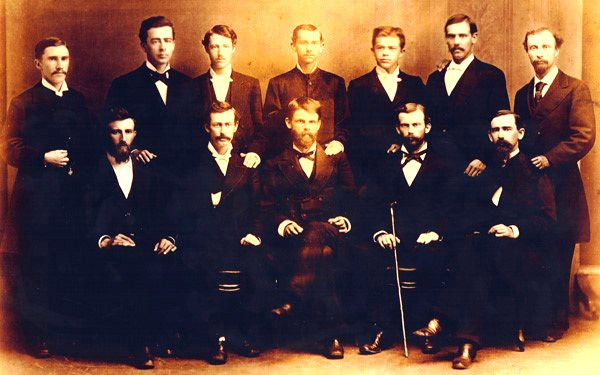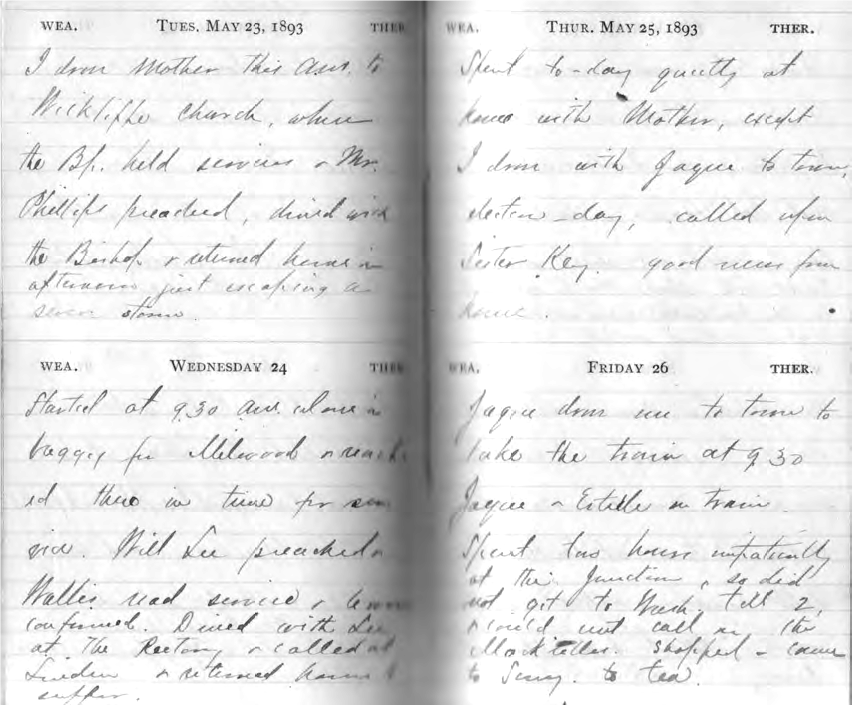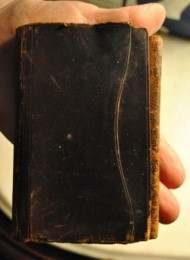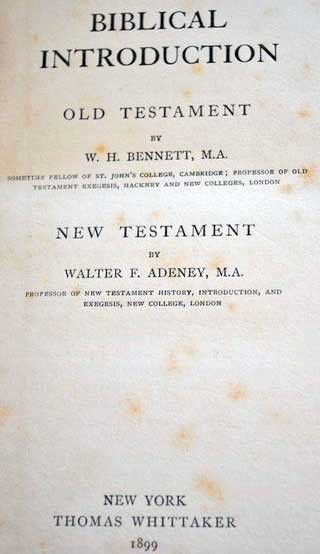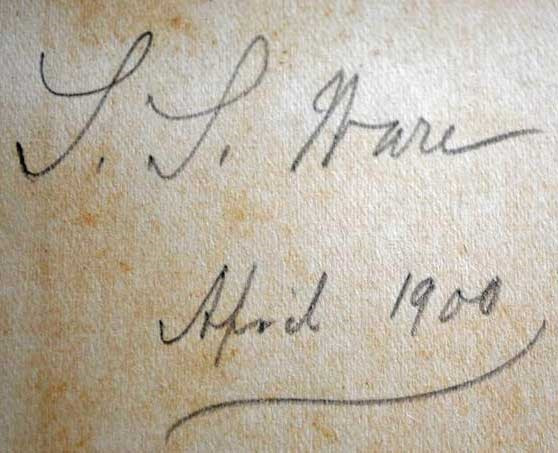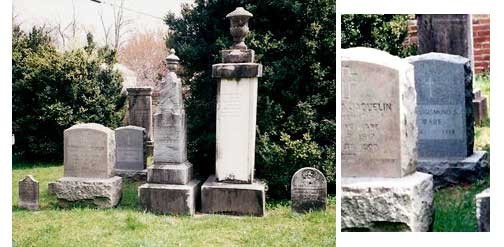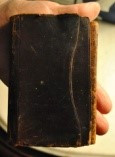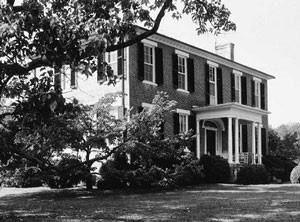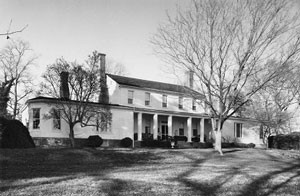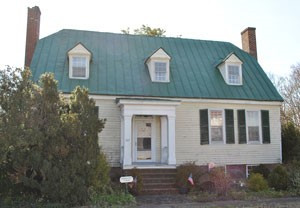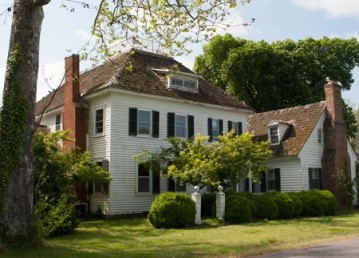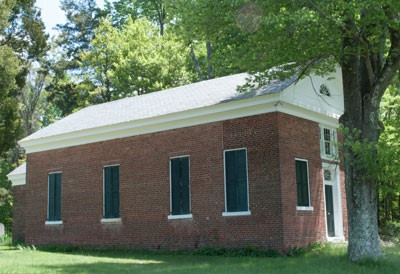|
Written
by Ben
Hicks – husband of 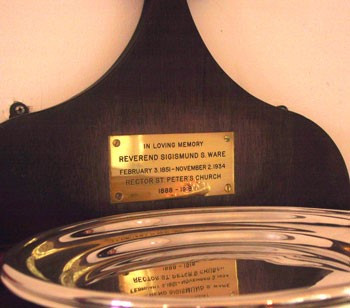 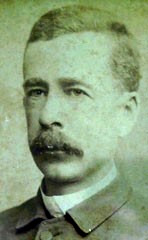 Except
for our first rector William Friend (1836-1870), no one preached longer
at St.
Peter’s than Sigismund Stribling Ware or as he was known, “Sig”. His
years at
St. Peter’s spanned 1888-1918. During much of that time he preached at
Grace
Church (until 1903), St. Asaphs and St. Peter’s. Later in 1914 he later
added
Vauters.
Recently,
a copy of an 1893 diary of this rector has come to light from Cookie
Davis.
1893 was in the middle of period between Reconstruction and World War
I. It
represented the last presence of 19th century life. A decade later
cars,
airplanes, a growing presence of electricity started forever changing
America. I
have been contact with Judy Ware, the genealogist of the Ware family,
who has
done an amazing amount of work on the Ware family. The diary is unknown
to them
and she is very excited over its uncovering.
The
blank diary was given to Ware at Christmas, 1892 by a Ms. Catlett. The
name is
either "N" or "H" Catlett. If "H" it could be
Harriet T. Catlett. In 1880's Robert and Catherine Catlett lived on Lot
44 with
8 children including Harriet. Ware
was a faithful diarist until Aug 13, 1893. Then it breaks off until Oct
1.
There are scattered days missing in Oct. and November. It is not clear
what
took him away from the diary during these periods. He had just
travelled to the
Chicago to visit the famous World’s Fair, celebrating the 400th
anniversary of
Columbus. The Fair was modelled after what a future city should be.
Ware notes
that October 1 was his first Sunday back at St. Peter’s Over
the next few weeks, I will be covering Rev. Ware and his diary. Ware‘s
family
was from Clarke County Va. where he was born in 1851. He was later
buried there
in 1934 at his death at Grace Episcopal. Ironically, this was my first
Episcopal Church. Ralph
Fall provides this assessment of Ware's years. "Fifty years later
citizens
both black and white still remembered Ware with affection." The minutes
added that "we will ever gratefully remember the faithfulness and
earnestness with which he ministered to us as a congregation and as a
community." The most visible honor is the brass table on the credence
shelf in the front of the church. On
Tuesday June 25, I was at a service at Aquia Episcopal of "Celebration
of
New Ministry" for Rev. Jay Morris and his new interim Connor Newlun.
While
there I mentioned to Virginia Theological's history professor Bob
Pritchard, an
old friend, that we had a new diary on Rev. Sigismund Ware. He took
that
information to one of their archivist, Christopher Pote who provided me
with
the above image of Ware's 1878 graduating class at VTS. Note that
Ware's
brother Josiah Ware was also a member of this class. The members were
researched by Pote who says it is one of VTS most important classes. It
is our
earliest picture of Sig Ware.
sample
page
Sigismund
Stribling Ware ("Sig") was priest at St. Peter's for 30 years
(1888-1918). Recently a diary he wrote has come to light. This
is not an easy diary to decipher. Ware’s 1893 diary was a diary with 4
days on
two pages, so he abbreviated and wrote small with names that cannot be
deciphered. There is only a limited amount of text for a given day. We
don’t
know who he is writing for. Maybe only for himself and so it is more of
a
journal recounting his days. It’s
only 120 years ago the Rev. Ware wrote the diary in 1893 but what a
difference
from our time. This is a different world, one between the Civil War
mindset and
the horror of WWI but before some of those modern conveniences have
been
invented. Take
out modern forms of transportation (automobile), modern media (TV,
radio),
modern forms of communication (internet) and other conveniences,
electricity
among many things. It certainly must have been more quiet time, more in
harmony
with nature and with intimate personal contacts, probably fewer in
number. It
is a more formal time with Ware addressing people as “Mr” or “Mrs”, not
Dick or
Jane. Rev. Ware was a man of habits. He takes his “usual walk” (though
never
describes what this is), takes tea in the afternoon and is very
observant of
nature. One place he often visited was walking with his daughter
Cornelia to
Catlett Hill just beyond today the intersection of Route 17/301. He
thrives on
human contact, visiting parishioners and non-parishioners. What
motivated him? Certainly his work as a minister of God but beyond that
gardening, reading (particularly biography) and letter writing. He was
reading
the “Life of Wordsworth”, and the “Life of Dr. Pendleton” earlier in
the year.
(The latter was a Baptist minister born in Spotsylvania, leaving the
south in
the Civil War over the issue of slavery). He read newspapers and kept
up with
events, noting on Jan 24, the death of famous Minister Phillips Brooks
and
writing in May 1 about the opening of the Chicago World’s Fair. 1893
seemed like a happy time for him – before he lost two of three children
and his
wife. He could only have managed this through the support of friends
and
parishioners. He has his 43rd birthday in 1893 and celebrated at the
end of the
year his 5th anniversary at St. Peter’s. He lived in the current
rectory. He
talked about mending the fence in front of the house. Ware
is both minister to Grace Church in Corbin and St. Peter’s in Port
Royal,
alternating between them on Sunday. For “Grace Sundays” he usually
started to
Grace on Sat. at 2pm to 3pm for a several hour drive in his horse and
buggy. He
usually stayed at Santee (dining with Mr. Dickinson, Mr. Gordon) or at
Nottingham, one or two nights. In this time, both morning and evening
services
were held. Easter was on April 2 and during Lent they had additional
services
on Tuesday and Thursday. In any case, he didn’t venture far – usually
between
Corbin and Port Royal. The
diary throughout January was involved with the weather. It was cold in
Port
Royal – down to 10 below zero, the river frozen in some of the darkest
times of
the year. On Jan 24 he reported he “walked over on the ice and called
at
Woodlawn.” He was susceptible to colds and notes problems with his
ears. On Sat
Jan. 8 he wrote, “It was cold and snowing this am so we did not start
to Grace
Church; tried to get over river to service but failed.” On Sunday, Jan
15 at
St. Peters’ he had a “good congregation despite the weather”.
“Conducted the
S.S (Sunday School)”. “Preached a messy service. No choir.” Walked with
“H*” in
the PM but too cold”. Preached on John 1.29. It was often too cold for
his
“usual walk.” Some
things never changed with ministry. He usually took Saturday to prepare
his
sermon (Exodus 4:2 on Feb 4) and by Monday he was exhausted. He wrote
on Jan.
30 – “Felt tired after yesterday’s unsatisfactory services.” A new
prayer book
in 1892 was printed a year earlier though he doesn’t comment on that
and
whether either church had bought a supply Much
of the time is taking up with visits. To whom did he visit ? To really
understand this diary, a census of Port Royal at the time and a
parishioner
list are essential. A short list includes Miss Virginia Thornton, Mrs.
Brookes
the Farishes, the Catletts, the Lightfoots Dr. and Mrs. Gravatt, the
Robbs of
Gay Mont, Mr. Burrows, Loula M. He called on them, they called on him
and he
invited them to tea. Sickness and illness as with today were motivators
for
visits as they are today. On Jan. 17th “called on Miss Sarah Jane who
is sick
in bed.” On March 14, . “I went over to Dr. Jett’s to see Dr Jett about
L who
is not well.” By
the end of March, it was time to prepare his garden. He planted several
crops
of corn, potatoes, tomatoes and beans. We don’t get an idea of where he
had his
garden. Next week will look at Easter and beyond. Last
week we heard that a 1893 diary of our 30 year
rector Sigismund Stribling Ware (1888-1918) had been found. Before we
get into
the diary, some background of the man might be in order. I am indebted
to Judy
Ware and her website www.waregenealogy.com
for this information. Sigismund’s
parents were Josiah and Edmonia Ware. Josiah William
Ware was owner of Springfield Plantation in Clarke County. Born in
1802, he was
active in the creation of Clarke County, corresponded with many of the
key
political leaders of the time, such as Clay, Webster and Calhoun, and
raised
prize winning sheep. His cousin Lucy became the wife of President
Rutherford B.
Hayes. Ware’s family extended back to James Ware I and his wife, Agnes
Todd
Ware who settled in Gloucester County, Virginia in the 1700’s Sig
had an older brother, Jaque. Being older, however, Jaque
joined the Confederate Army while his younger siblings were still at
home. There
is a story of how young Sigismund drove a carriage through
enemy lines to help bring a pair of boots to his older brother. He was
only 12
years old at the time: “At
times a soldier, when
near enough to his home and when he could be spared, would get a
furlough to
visit his home for a few days. On one such occasion Jaque got as far as
the
east side of the river, then he learned that the Union soldiers in the
country
were in such numbers that he could not reach home. His whereabouts
became known
through underground telegraph and Mother and ‘Sister Anne’ Stribling
started in
the carriage with old blind ‘Queen’ and ‘Sig’ as driver to ‘spend the
day with
a friend.’ Under her hoops Mother carried a pair of big cavalry boots .
. .
suspended from her waist. In the boots were, I am confident, some yarn
socks
and I do not know what else.” He
later graduated from Episcopal High, he ventured to
Indianapolis and worked in a relative’s wholesale business and then
came back
to Virginia to enter Virginia Theological Seminary. Sig’s daughter
Cornelia
later wrote, “Father had done very well
financially in Indianapolis and was able to pay his own way through the
seminary and also help his younger brother with his education." He
was
ordained a deacon in 1878 and a year later as a priest. In 1878, he
also
married Elizabeth Walker, daughter of Cornelius Walker a professor
there. He
served two parishes before coming to St. Peter’s - Antrim, Halifax
County,
Virginia from 1878-79. and 1879 to 1888 in Shelburne Parish, Hamilton,
Virginia Based
on Rev. Fall’s Hidden Village, Ware was very much admired and
endeared
to the community, he suffered losses – his son Edward 1896, an infant
daughter
Edmonia Jaquelin Ware (1890) and later his wife in 1914. One daughter
Margaret
Cornelia Ware (“Cornelia”) lived from 1887-1978, marrying John Anker
who worked
for the federal government. It was Cornelia who transcribed numerous
letters of
the family. From the diary, he loved to garden, take walks and read. It is rare to find a page where did not mention visiting someone in the village. In the sacristy are several books that he owned and two that Cornelia owned. Here is one with his signature in the inside front cover:
Ware
left St. Peter’s in 1918 and lived until 1934. Apparently he was a much
beloved
man. Rev. Fall in his book Hidden Village writes “Fifty years
later,
citizens both black and white still remembered Ware with affection.”
The
credence shelf in the church sanctuary holds a brass tablet as a
memorial to
Ware. The
Vestry inscribed in the minutes to his honor, “We reluctantly accept
the
resignation of the Rev. S.S. Ware, but we cannot refrain from
expressing our
deep regret that the pleasant and cordial relations existing between
us, as
Vestrymen and individuals, for 30 years shall now be severed, and we
will ever
gratefully remember the faithfulness and earnestness with which he
ministered
to us as a congregation and as a community.” He was buried in Grace
Episcopal
cemetery in Berryville which has a close connection to the family. Here
is the
Ware section of the cemetery in the left picture. He is buried behind
his
mother in the right picture.
Sigismund
Stribling Ware ("Sig") was priest at St. Peter's for 30 years
(1888-1918). Recently a diary he wrote has come to light. This is part
4 of the
series, covering the second quarter of 1993. Last
week we covered the diary through the first quarter of 1993, getting to
know
him and the environment in which he worked. Seasons
change and so does Rev. Ware’s lives. Apparently, the second floor of
the
rectory was too hot in 1893 for the Ware’s. He writes on “We moved
downstairs
today.” Spring
finally came to Port Royal that year and Rev. Ware was an active
gardener. Snow
was on the ground as late as March 5. However, by March 22 he first
mentions
his “garden work.” Tomato plants put out first by the end of the month.
Work
intensified in early April. On April 5, he wrote that he had “planted
my beans
and 2nd crop of peas. Three weeks later, corn. The end of the month was
rainy.
On April 25, he exclaims ““A delightful rain, the very thing my garden
needs.”
However, by early his work slows with a cold. He did have help. On May
30 he
writes, “Had Reuben in the garden most of the day also did some work
myself.” We
also
learned that Ware was a baseball fan not just watching it but playing
it. He also
was an occasional fisherman, fishing with Mr. Inscoe. Ware
took at least two extended trips during this period. First was
“convocation” at
Lancaster Courthouse. This appears to have been similar to our Region
organization in the Diocese today. He writes on April 10 – “took the
boat at
night for convocation at Lancaster CH, met Dr. P_________ on the boat.
“It
looks like it was a timer of fellowship, services and business. “We had
a
devotional meeting at ______ and Latane gave us a good address.
Business
meeting. Service at night with addresses by Dr. Powers, Dr. Handley.”
Finally We
got up at 3am and walked Mossy Point at light. Took the boat for
_________. He
also
attended Annual Council of the Diocese of Virginia which was held in
May in
those years. In 1893, it was held in Winchester near Clarke County
where his
family lived. He took the train to Fredericksburg on May 15 to
Washington and
then to Berryman. “Jaque met me in Berryville and was glad to get
home.” “Jaque
drove me up to Winchester in time for the opening services of Council.
G. W.
Nelson preached on “Pray for the Peace”. I represented the Rappahannock
Convocation. “ He noted a few events. “Carmichael gave an excellent
sermon on
“They hated me without a cause” He visited Wickliffe church on May 23,
a
historic church near Berryville. Of
course, Ware was both minister to St. Peter’s and Grace at Corbin. He
had 39
communicants at Grace and 46 at St. Peter's based on the minutes of the
Annual
Council in 1892. Frustration is part of the life of a minister – then
and now.
At Grace on Sunday, April 23, “raw day for our services and a rather
small
congregation”. Most Vestry meetings were annual at best and typically
on
Mondays. On April 24, he writes “Had a meeting with the congregation
and re-elected
the old vestry who organized and attended to the same business.” Same
old. Same
old. Sometimes he was brutally honest with himself. Sunday June 11-
“was tired
and stiff from my game on Friday so was rather dull today.” In
June, the Bishop would visit. Due to distances, the Bishop made a grand
tour in
an area, preaching not just on Sundays as with today but on weekdays.
Ware
was diligent about preparing for that event. On May 7, he writes”
Preached on
Confirmation at St. Peter’s. Bishop visits this church June 12. My cold
bad
enough but did not affect my preaching. “On June 8, “saw Annie Holloway
about
confirmation.” On June 10, on the way to Grace church “Left home 3:30pm
to go
to Santee and after tea went to Cleremont and spent the night. Talked
to Belle
about confirmation. “He met Bishop Whittle on Monday the 26th with
services at
night at St. Peter's. Rev Everard Meade of Evangelist in Richmond
preached. He
had a good night - 5 confirmed. He
possibly knew Whittle from Grace Episcopal in Berryville where was
priest
1857-1868. He heard the Bishop again at Port Conway the next night.
Then on the
29th the Bishop was at Vauters and Rev. Ware preached. On the 30th the
Bishop
confirmed 5 at Grace. He had stayed at Camden the previous night and
they all
went to Corbin the next day. After the service, "we all dined at
Nottingham and we returned home to tea. Much
of
what Ware chooses to include involves visits. Dr. and Mrs. Gravatt was
a
constant visit. He noted on May 6 that "L and I drove to Gay Mont
and
called on Mr. Robb, gradually getting worse." Others include Miss Sally
Taft, Miss Virginia Thornton, Miss Sally Lightfoot, Miss, Sarah J.
Peyton, Mr.
G. B. Farish, Mrs. Quesenbery, Mr. Bowie, Wayne Myers and Dr. Holloway.
Sig's
Diary,
Homes and Locations in Rev. Ware's 1893 Diary Editor's
note - The idea of covering locations associated with Rev Ware, plus
most of
the pictures and the diary extracts are from Judy Ware who is the
genealogist
of the Ware family. One only has to look on her web site (http://www.waregenealogy.com/
to see the extensive work over many years she has done. Every family
should
have someone like her! The
1893 diary of Rev. Sigismund S. Ware contains a number of place and
names
regularly a part of his normal life. His universe was generally 20
miles north
(Corbin) and 5-20 miles south to take in Camden and Vauters. 20 miles
by horse
and buggy took 2 ½ hours as he mentioned in one entry in his diary. Walking
was his primary mode throughout the Port Royal area, up to Catlett Hill
and Gay
Mont, visiting parishioners and friends. He mentioned almost daily that
he took
his "usual walk" though never describes where he walked. For
distances outside of Port Royal he used his "horse and buggy" as he
called it. He
did take several trips in that year outside his normal stomping grounds
-
Berryville and Winchester for Annual Council, Lancaster Courthouse for
convocation (which appears to be similar to a regional church meeting)
and the
big trip to Chicago for the World's Fair. Here
are the most prominent homes mentioned: 1.
Santee. The
trip to Corbin every two weeks to preach at Grace led him to leave the
day
before about 2pm and stay many times at Santee in Caroline County:
Santee,
associated with the prominent Fitzhugh and Gordon families for over 250
years.
It passed to daughter, Sarah, who married Henry Fitzhugh. Their son
John
Battaile Fitzhugh owned the property until his own death in 1803, when
it
passed to his brother, who created the present Santee plantation. In
1817, he
added 166 acres to his holding, followed by another 300 acres the next
year.
Upon Fitzhugh's death, the property passed to his wife Elizabeth
Taliaferro. In
1838, an increase in valuation occurred with the addition of two brick
buildings, probably the kitchen and the stable, to the estate Patsy
Fitzhugh
and her husband Samuel Cordon of Kenmore, in Fredericksburg, inherited
Santee
from her mother. Descendants of the Fitzhugh and Gordon families owned
Santee until
well into the twentieth century. It was vacant from 1931 until 1943, at
which
time it was sold out of the family. Dec.
10, 1893 -
“I had service this beautiful day, but had only a
moderate congregation. Dined Santee, Mr. Garnett joined us, I returned
home to
tea. My subject was the collect for the Sun. The
illness of Mr. Robb consumed the 1893 diary. His death would be the
next year.
St. Peter's history is very much interrelated with the Robb family.
Gay
Mont was built on a site overlooking the Rappahannock River in the
latter part
of the eighteenth century by John Hipkins (circa 1749-1804), a merchant
of Port
Royal, on land he gathered between 1786 and 1799. In 1816, Bernard
married Jane
Gay Robertson (1795-1852) and gave his estate the name of "Gay Mont"
in honor of his wife. Bernard died in 1858 and three of his children
purchased
the house and 445 acres from the other heirs. One of these, Helen
Struan
Bernard, acquired the homeplace in 1865 after her marriage to her
cousin,
Philip L. Robb, grandson of John Hipkins Bernard's sister. Gay Mont
remained in
the hands of the Robb heirs until it was sold in 1958.
Nov.
1 -“The
weather continues good. After my usual walk & work - Miss Patsy
came to ask
me to drive Miss Rosalie Meade to Gay Mont which I did. Letter for Miss
Nannie Dec.
8
-“The weather continues cold & fair, took my usual walk, heard from
Mother
& she tells me I must take my contemplated trip.” Dec.
16
-“A frosty & beautiful morning, the snow thawed very much. Read the
President’s message – went up to Gay Mont to call after pt. Twice Mr. A
excused
himself” Nov.
13
-“Spent the night at the Glassell’s, called on Mrs. Baker & Mrs.
Montgomery
& dined at Mrs. W. S. Broaddus. Returned home by 5:30 & found a
welcome
& all well.” Monday – The
Glassells were relatives from Josiah Ware’s first wife’s family. Her
name had
been Fanny Glassell Ware 3.
Moss Neck 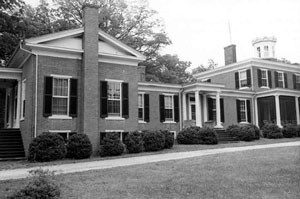 Built circa 1856 for James Parke Corbin, member of one of the
Commonwealth’s
oldest and most eminent landed families - the house is one of the
longest in
Virginia. Confederate Stonewall Jackson used the plantation for
encampment. June
12
– After my usual walk I drove Mr. Dickenson over to Moss Side_ , he
walked with
me to Moss Neck to call on Mr. J. P. Corbin 4.
Camden. 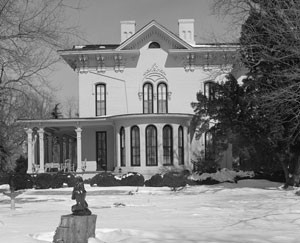 Camden
was built on the site of an earlier house belonging to the Pratt family
that
dated to 1760. William Carter Pratt demolished this house around 1856
to use
the prominent site for a new house. He engaged Baltimore architect
Norris G.
Starkwether, with construction stating in 1857, completed in 1859. It
was built
in the Italian-village style clad with flush siding that was originally
treated
to resemble stone. The tower base projects from the front, with a
semicircular
porch surrounding its base, looking out over the Rappahannock River.
The first
floor includes a central hall, library, dining room, parlor and a
main-level
bedroom. The parlor retains its original Victorian rococo furnishings. Up-to-date
in style and technology, the house was equipped with central heating
and
cooling, gas lights and running water. A private gas works was
installed to
generate gas for the lights. The house's tower was destroyed by a hit
from a
Union gunboat in late November 1862 and never restored. Feb.
3 –
Rode with Dr ____ . Rode Seawind to Camden and returned in time for
tea. Mr.
Pratt later returned from Portsmouth. My 42nd birthday, Cornelia pm had
a tea
party. June
30
– Bishop Meade staid at Camden last night and went from there to Grace
Church.
Lizzie went with me. Meade Clarke gave us an excellent sermon __ the
Thorns. 5
were confirmed, we all dined at Nottingham and we returned home to
tea. July
27
– I drove John Gravatt to Camden and we dined there. Talked quite
awhile at Mr.
Taylors July
28
– Called on Dr. Gravatt and also on the Owens and Dr. Jetts to see Mrs.
R. C.
Jett but she was at Camden. The Taylor girls called 5.
Nottingham. Nottingham
was located seven miles south of Fredericksburg in Spotsylvania County,
Virginia. The land was owned by Governor Alexander Spotswood from 1722
to 1740,
and he evidently named it for the location in England where he and his
brother
John boarded and attended school. The original house burned and was
rebuilt by
W. L. McCarthy Spotswood Feb
26
– Text James 11.2 “Dined with Dr. L _____, called on Wayne Myers /and
spent
last night at Nottingham.” Feb
27
– Did not leave Nottingham until 9:50am.” On way called at _______ and
dined at
Santee.” Called on Uncle William Young who is sick. April
8
- Distinguished by my taking Cornelia for the first time. Went to Grace
– spent
night at Nottingham. 6.
Catlett home, Port Royal
Built
in 1760, on the east side of King Street, it has been in the Catlett
family for
a hundred years. In 1880's Robert and Catherine Catlett lived here with
8
children. It was a Catlett (below) that in 1892 presented a blank diary
to Rev.
Ware for 1893. Robert Farnish purchased it in June 1924. 7.
Old Gravatt Place
Old
Gravatt Place Port Royal, on Market Street. The one and one-half story
part of
the house was built about 1780. The two story was built about 1835, and
the new
two story part was built in 1909. Primary owners, Mr. Timberlake, Dr.
John
James Gravatt was the next owner and he owned the estate for eighty
years. He
died in September 1896 and the house went to his son, Dr. Charles
Urquhart
Gravatt who owned it until his death in April 1922. It was next
purchased by
Lena Hicks DeBruin who died in December 1981 Mar
13
– "Drove to Gay Mont and had a pleasant trip. Dr. Gravatt and family
paid
a visit." Mar
20
– "took Dr. Gravatt a drive out to Gouldmans" April
17
– "took dinner at Dr. Gravatts" April
21
– "the wind blew like a hurricane today. Called on Dr. Gravatt’s, quite
sick there." April
26
– "Called on the Gravatts – they not well" May
5
– "Dr. and Mrs. Gravatt came to tea" May
12
– "Dr. Gravatt and I play ball with the boys this PM " June
15
– "I sat awhile at the Gravatts." July
28
– "Called on Dr. Gravatt and also on the Owens and Dr. Jetts to see
Mrs.
R. C. Jett but she was at Camden. The Taylor girls called" 8.
Grace Episcopal, Corbin, Va.
Grace
Episcopal extends back to the 1830's. Rev. Ware was rector from 1888
there
until 1903 when the Grace Vestry was unable to raise its share of
Ware's
salary. Ware would preach one week at St. Peter's and the next at
Grace. He then devoted his full time to
St. Peter's
Church and then to the future St. Asaph's in Bowling Green. It
took approximately 2.5 hours by horse to go the 20 miles from St.
Peter's. He
usually started in mid-afternoon on Saturday and stayed overnight with
friends
at Santee or Nottingham. He often extended his visiting on Sunday not
arriving
back at Port Royal until late Monday. Today,
the church is defunct but is maintained by the Corbin family. In the
early
years of his ministry the different in size between the churches was
not great.
In 1891, for instance, Grace had 36 parishioners and St. Peter's 46.
Unlike St.
Peter's there was no Sunday school. Sunday
Jan 8
– “It was cold and snowing this am so we did not
start to Grace Church; tried to get over river to service but failed”
and
attended service at the M____ church at night and took the children
walking in
“___” on the ice." Feb
11-
"Went to Grace church and spent the night at Santee____ pleasantly with
Mr. Gordon and Mr. H. H. Dickenson. " Feb
25 –
“Got off by 2 to Grace neighborhood and spent night at Santee” April
8 -
"Distinguished by my taking Cornelia for the first time. Went to Grace
–
spent night at Nottingham" April
22
– "Went off at PM to Grace and stayed at Santee. Letter from L. She and
the children are enjoying their stay at Hamilton?" June
25
– "Preached at Grace Church this am dined at Chestnut Valley.” The
concept of Founders Day is not new.
We have always celebrated our history. You may remember the play
written by
Nancy two years ago for the 175th anniversary. We just will be more
deliberate 2013
is the 177th year since
consecration, and we will honor Rev. Sigismund Stribling Ware during
the church
service. There are several reasons. Based on Fall's history he is one
of the
most beloved priests to serve. And he served 30 years with 1913 the
125th years
of the beginning of his service. To top it off, Cookie has revealed a
diary of
Ware's which takes place in one year, 1993. There are also Ware
relatives
around. |
|
This site maintained by John Reagan and last updated October 17, 2017 |
